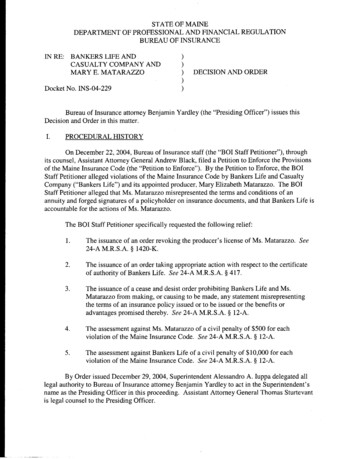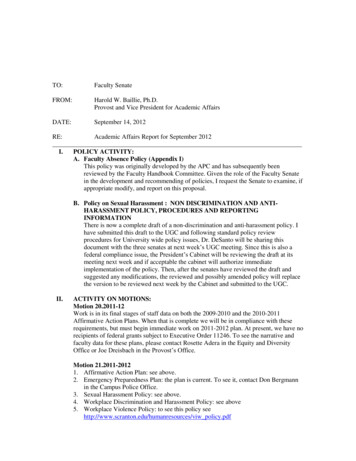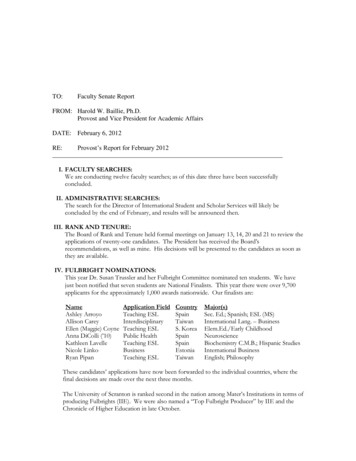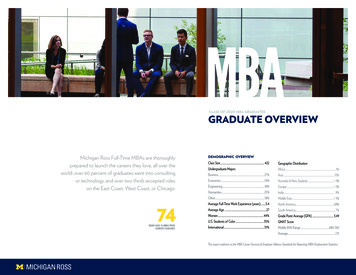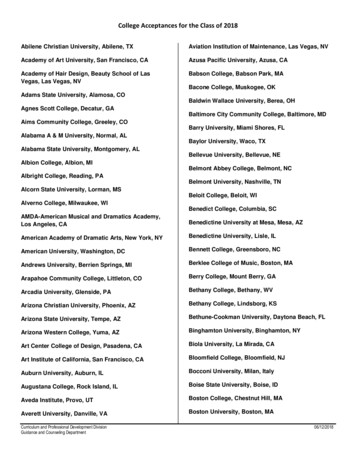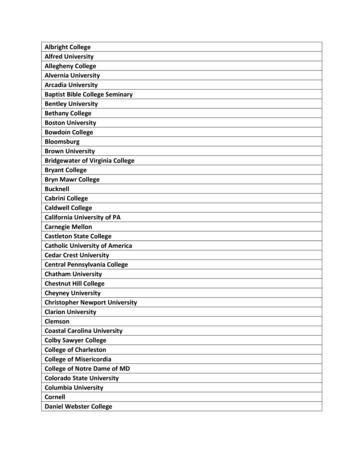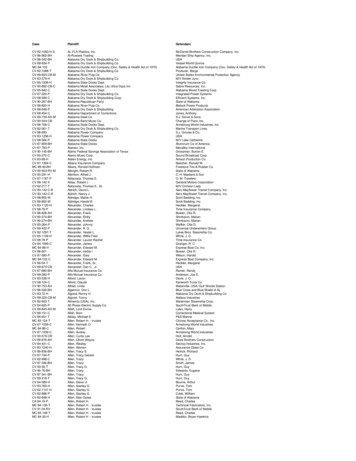
Transcription
Page 128The information in this chapter was last updated in 1993. Since the money market evolves very rapidly, recentdevelopments may have superseded some of the content of this chapter.Federal Reserve Bank of RichmondRichmond, Virginia1998Chapter 10BANKERS ACCEPTANCESRobert K. LaRocheA bankers acceptance, or BA, is a time draft drawn on and accepted by a bank. Before acceptance, the draftis not an obligation of the bank; it is merely an order by the drawer to the bank to pay a specified sum ofmoney on a specified date to a named person or to the bearer of the draft. Upon acceptance, which occurswhen an authorized bank employee stamps the draft "accepted" and signs it, the draft becomes a primaryand unconditional liability of the bank. If the bank is well known and enjoys a good reputation, the accepteddraft may be readily sold in an active market.THE CREATION OF A BANKERS ACCEPTANCEAcceptances arise most often in connection with international trade: U.S. imports and exports and tradebetween foreign countries.1 An American importer may request acceptance financing from its bank when, asis frequently the case in international trade, it does not have a close relationship with and cannot obtainfinancing from the exporter it is dealing with. Once the importer and bank have completed an acceptanceagreement, in which the bank agrees to accept drafts for the importer and the importer agrees to repay anydrafts the bank accepts, the importer draws a time draft on the bank. The bank accepts the draft anddiscounts it; that is, it gives the importer cash for the draft but gives it an amount less than the face value ofthe draft. The importer uses the proceeds to pay the exporter.The bank may hold the acceptance in its portfolio or it may sell, or rediscount, it in the secondarymarket. In the former case, the bank is making a loan to the importer; in the latter case, it is in effectsubstituting its credit for that of the importer, enabling the importer to borrow in the money market. On orbefore the maturity date, the importer pays the bank the face value of the acceptance. If the bankrediscounted the acceptance in the market, the bank pays the holder of the acceptance the face value onthe maturity date.1 Although acceptances may be created by entities other than banks—such acceptances are referred to as "tradeacceptances"—the term "acceptance" in this chapter will refer to bankers acceptances only.
Page 129An alternative form of acceptance financing available to the importer involves a letter of credit. If theexporter agrees to this form of financing, the importer has its bank issue a letter of credit on its behalf infavor of the exporter. The letter of credit states that the bank will accept the exporter's time draft if theexporter presents the bank with shipping documents that transfer title on the goods to the bank. The banknotifies the exporter of the letter of credit through a correspondent bank in the exporter's country.When the goods have been shipped, the seller presents its time draft and the specified documents tothe accepting bank's correspondent, which forwards them to the accepting bank. If the documents are inorder, the accepting bank takes them, accepts the draft, and discounts it for the exporter. At this point, thetransaction is complete from the exporter's point of view; it has shipped the goods, turned over title to them,and received payment.Once the bank has passed the shipping documents on to the importer, the situation is essentially thesame as it was in the case where the bank simply accepted a draft drawn by the importer: The bank mayhold the acceptance or rediscount it in the market, and the importer is responsible for paying the bank theface value of the acceptance on or before maturity. There is one subtle difference, however. The drawer ofan accepted draft is secondarily liable on it, which means the drawer must pay the holder of the acceptanceon maturity if the bank is unable to pay. In the current case, the drawer is the exporter. In the first casedescribed, it was the importer.An American exporter may seek acceptance financing in a case where it knows the buyer to becreditworthy and wants to extend it credit but needs cash in the interim. Around the time it ships the goodsand after completing an acceptance agreement, the exporter draws a time draft on its bank, which acceptsand discounts it. Once again, the bank may either hold the acceptance or rediscount it. On or beforematurity, the exporter will have to pay the bank the face value of the acceptance. Ideally, the tenor of theacceptance, the time from acceptance to maturity, will coincide with the length of the credit extended by theexporter so that the exporter will be able to pay the bank out of the proceeds of the sale.Foreign importers and exporters trading with American firms may obtain acceptance financing in wayssimilar to those just described. Many acceptances used to finance trade between foreign countries,however, are of a type known as "refinancing" or "accommodation" acceptances. A refinancing acceptancearises from a time draft drawn by a foreign bank on an American bank to finance a customer's transaction.Foreign banks that are not well known in the United States may seek this type of financing because they areunable to sell their own acceptances, or are unable to sell them at reasonable prices, in the U.S. market.Acceptances are also created to finance the shipment of goods within the United States and to financethe storage of goods in the United States and abroad. Acceptances arising from the shipment and storage ofgoods in the United
Page 130FIGURE 1Bankers Acceptances Outstanding by Transaction TypeQuarterly Averages of Month-End FiguresNote: Figures are from the Board of Governors' Annual Statistical Digestand Federal Reserve Bulletin.States, which are termed "domestic" shipment and storage acceptances, are included in Figure 1 under"other," which includes dollar exchange acceptances—acceptances created to provide banks in certainforeign countries with dollar exchange—until 1984 when they disappeared from the market. As Figure 1shows, domestic shipment and storage acceptances have been a small part of the market in recent years.On average during 1991, they accounted for 10 percent of acceptances outstanding. Acceptances arisingfrom imports into the United States accounted for 28 percent, those arising from exports from the UnitedStates accounted for 24 percent, and those arising from the storage of goods in or shipment of goodsbetween foreign countries accounted for 38 percent.BANKERS ACCEPTANCES AND THEFEDERAL RESERVE SYSTEMAcceptances created to finance the activities listed above—U.S. imports and exports, foreign shipment andstorage of goods, the shipment and storage of goods
Page 131within the United States, and the provision of dollar exchange—are termed "eligible for discount" if they meetcertain additional requirements laid out in the Federal Reserve Act. Eligibility for discount means that aReserve Bank may rediscount them for accepting banks at the Federal Reserve's discount rate.The Federal Reserve Act limits the ability to create eligible acceptances to Federal Reserve memberbanks and to branches and agencies of foreign banks that must hold reserves with the Federal Reserve.2Technically, the acceptances of other depository institutions are eligible only if they are endorsed by at leastone member bank. In practice, the Federal Reserve has treated the acceptances of other depositoryinstitutions as eligible even without such an endorsement (Todd 1988, pp. 272-73).The Federal Reserve Act places no limits on the types of goods that may be financed by eligibleshipment acceptances (those arising from U.S. imports and exports and from the domestic and foreignshipment of goods). The Federal Reserve Act limits eligible storage acceptances, however, to thosefinancing the storage of "readily marketable staples." In an early ruling, the Board of Governors interpretedthe phrase to cover manufactured goods and raw materials that are nonperishable and have a "wide readymarket" (Federal Reserve Bulletin 1916, p. 523). In the same ruling, the Board stated that cotton yarns andflour are covered. The Board later ruled that automobiles and automobile tires and parts are not (FederalReserve Bulletin 1920, p. 65).The Federal Reserve Act places on storage acceptances the added requirement that they be "securedat the time of acceptance by a warehouse receipt or other such document conveying title." Congressremoved a similar documentary requirement for domestic shipment acceptances in 1982.To be eligible for discount, acceptances must meet requirements concerning tenor. A dollar exchangeacceptance must have a tenor of three months or less. Any other type of acceptance must have a tenor ofsix months or less.3 However, the Federal Reserve has made it clear from early on that meeting theserequirements on tenor does not guarantee eligibility. An acceptance will be eligible only if its tenor roughlycorresponds to the time required for the completion of the underlying transaction.In addition to allowing Reserve Banks to rediscount acceptances for accepting banks, the FederalReserve Act allows them to purchase acceptances in the open market, but it does not specify what types ofacceptances they may purchase.2 There is another category of "eligible" acceptances, those eligible for purchase (described below). Even though there are twotypes of eligibility, acceptances that are eligible for discount are often simply called "eligible," while those that are not are called"ineligible."3 A Reserve Bank may not actually discount an eligible acceptance until it has 90 days or less left to run, unless it is a storageacceptance "drawn for an agricultural purpose," in which case it may be discounted when it has six months or less left to run.
Page 132The Federal Open Market Committee determines which acceptances are "eligible for purchase."Acceptances that qualify are thosewith maturities of up to nine months at the time of acceptance that (1) arise outof the current shipment of goods between countries or within the United States,or (2) arise out of the storage within the United States of goods under contractof sale or expected to move into the channels of trade within a reasonable timeand that are secured throughout their life by a warehouse receipt or similardocument conveying title to the underlying goods. (Board of Governors 1993,79th Annual Report, p. 110)Note that dollar exchange acceptances and acceptances arising from the storage of goods in foreigncountries are not eligible for purchase and that domestic storage acceptances may be eligible for purchaseonly if secured throughout their life by documents conveying title to the goods; storage acceptances may beeligible for discount if they are secured at the time of acceptance by such documents.The preceding rules on eligibility for purchase and for discount are those currently in force. The originalFederal Reserve Act limited eligibility for discount to acceptances "based on the importation or exportation ofgoods." 4 Congress amended the Act in 1916 to include acceptances arising from the storage of readilymarketable staples, from domestic shipments, and from the furnishing of dollar exchange. Until April 1974,when the current rules on eligibility for purchase went into effect, all acceptances that were eligible fordiscount, along with some others, were eligible for purchase.The framers of the original Federal Reserve Act gave the Reserve Banks permission to discount andpurchase bankers acceptances because they hoped to create a market for acceptances in the United Statesand to thereby stimulate American foreign trade by lowering the financing costs faced by American importersand exporters.5 In the years before the Federal Reserve Act was passed, most international trade wasfinanced with acceptances created under letters of credit (Warburg 1910, p. 9). The lack of an Americanmarket for acceptances meant that American firms engaging in foreign trade had to obtain financing fromEuropean banks, primarily those in London. Financing through London was thought to force Americanimporters and exporters to pay more in commissions than they otherwise would have had to pay, and, sincetheir4 This included foreign shipment acceptances, as the Federal Reserve Board construed "importation" and "exportation" to includethe movement of goods between foreign countries as well as between the United States and a foreign country.5 Hackley (1973, pp. 53-54), in making this point, quotes from speeches made by Congressman Phelan and Senator Swansonduring their respective houses' debates on the Federal Reserve Act. Congressmen Borland, Bulkley, and Helvering expressedthe same sentiment (U.S. Congress 1913, Congressional Record, pp. 4733, 4785, 4794, and 4798-99).
Page 133obligations to the banks in London were denominated in pounds sterling, to expose them to exchange raterisk ( Jacobs 1910, p. 13).6The Federal Reserve Banks actively supported the nascent market in the first 18 years following thepassage of the Federal Reserve Act. They did so mainly by purchasing acceptances in the open market andnot by discounting acceptances offered by accepting banks, the means Congress had expected them touse. They posted buying rates on prime acceptances and bought all acceptances offered at those rates; attimes, the posted rates were substantially below market rates. On average, from 1916 to 1931, the ReserveBanks held for their own portfolios over one-third of all outstanding acceptances; at times they held over halfof them. They also purchased acceptances for foreign official institutions that held correspondent accountswith them. They endorsed these acceptances, thus freeing their foreign correspondents from the risk ofdefault. Partly on the strength of the Reserve Banks' endorsement, their foreign correspondents purchasedlarge numbers of acceptances. From 1925 to 1931, the foreign correspondents held on average about onefifth of all acceptances outstanding.With the support of the Reserve Banks and their foreign correspondents, the acceptance market quicklyrose in prominence. As Figure 2 shows, from 1925 to 1931, acceptances financed on average about onethird of U.S. imports and exports. In 1931, the peak of their importance, they financed just under half.The support of the Reserve Banks and their foreign correspondents fell off dramatically in 1932. Fromthe middle of 1934 until late 1946, they stayed out of the market for the most part. The decline in theacceptance market was equally dramatic, and by 1943 the fraction of America's foreign trade financed byacceptances had fallen to 3 percent.The market began growing again following World War II, and the Reserve Banks' foreigncorrespondents resumed regular purchases in late 1946. The Federal Reserve re-entered the market in1955 when the Federal Open Market Committee authorized the Federal Reserve Bank of New York to enterinto repurchase agreements (RPs) in acceptances and to buy and sell acceptances at market rates asmeans of carrying out the Committee's monetary policy directives. The Federal Reserve sought to supportthe market, but not to the extent it had in the 1920s. Since 1955, the Federal Reserve and its foreigncorrespondents combined have not held more than 20 percent of the acceptances outstanding.During the 1970s, the Federal Reserve decided that the acceptance market had matured to the pointthat it could stand on its own, and the System gradually withdrew its support. In November 1974, it stoppedendorsing acceptances for its foreign correspondents. In March 1977, it decided to stop outright purchases6 Congressmen Phelan and Helvering quoted from Professor Jacobs during the House's debate on the Federal Reserve Act(U.S. Congress 1913, Congressional Record, pp. 4676 and 4798-99).
Page 134FIGURE 2Shares of U.S. and Non-U.S. International TradeFinanced by Bankers AcceptancesNotes: Acceptance figures are from the Board of Governor's Banking and Monetary Statistics, Annual Statistical Digest, andFederal Reserve Bulletin. U.S. imports and exports are from the U.S. Bureau of the Census' Historical Statistics, StatisticalAbstract, and FT900 release. Trade figures for the rest of the world are from the International Monetary Fund's InternationalFinancial Statistics. Shares financed are based on an average maturity of 90 days.and sales of acceptances, and in 1984 it decided to stop entering into RPs in acceptances.Even though the Federal Reserve Banks have stopped buying and selling acceptances for their ownaccounts, eligibility for purchase and eligibility for discount remain significant in that acceptances that areeligible for discount or purchase enjoy favorable treatment in certain areas. Acceptances must be eligible forpurchase in order to be bought for the Federal Reserve's foreign correspondents, and they must be eligiblefor discount or purchase in order to be used as collateral for advances from the discount window. From 1973to the end of 1990, eligibility for discount conferred an additional benefit: Acceptances outstanding in themarket had to be eligible for discount in order to be exempt from reserve requirements.The exemption from reserve requirements was a significant factor in the growth of the acceptancemarket in the late 1970s and early 1980s (Jensen and
Page 135Parkinson 1986, pp. 5 and 8). The high interest rates in those periods raised the opportunity cost of holdingreserves, which do not earn interest. This made it attractive for banks to finance eligible transactions bycreating acceptances, discounting them, and rediscounting them in the market rather than by loaning outfunds obtained by issuing large CDs, which were subject to reserve requirements.The value of the exemption is evident in the experience of "working capital" or "finance" acceptances,which are acceptances that do not arise from specific transactions in goods. Of these acceptances, onlydollar exchange acceptances are eligible for discount. In July 1973, the Board of Governors started treatingineligible acceptances discounted in the market as equivalent to deposits subject to reserve requirements.Judging by dealers' holdings of working capital acceptances, trading in them had been increasing for at leasttwo years.7 After the imposition of reserve requirements, trading declined steadily, and, aside from a briefand minor revival in the early 1980s, it has been dormant ever since.At the end of 1990, the Board of Governors removed reserve requirements from "nonpersonal timedeposits," which include ineligible acceptances and large CDs, and from Eurocurrency liabilities, which arenet transfers from banks' overseas offices to their U.S. offices. This action bodes ill for eligible acceptances,since it puts CDs and Eurodollar liabilities on a more even footing with them. Even with favorable reserverequirement status, eligible acceptances had been declining in importance for close to a decade. Judging bythis experience, it seems unlikely that the Board's action will lead to a revival in ineligible working capitalacceptances.THE MARKET FOR BANKERS ACCEPTANCESBorrowersBorrowers in the acceptance market are for the most part firms engaged in U.S. imports andexports and foreign banks seeking to finance international trade not involving the United States. Over thelast decade, as Figures 1 and 2 show, both types of borrowers have come to rely less and less onacceptances as a source of financing.As a source of financing for importers and exporters, acceptances compete with commercial paper,Euro commercial paper, and bank loans. For borrowers with prime ratings, commercial paper is probably thecheapest alternative. Borrowers with less than prime ratings can take out bank loans, issue Euro commercialpaper, issue commercial paper with credit enhancements, or issue asset-backed commercial paper.Borrowers of the latter type may find acceptance financing an attractive alternative.7 Figures on dealers' holdings of acceptances can be found in the Federal Reserve Bank of New York's weekly report "DealerOperations in Bankers' Acceptances."
Page 136Apparently, however, they increasingly do not. From 1983, when asset-backed commercial paper andEuro commercial paper were introduced, until 1991, outstandings rose to between 50 billion and 70 billionfor asset-backed commercial paper and to 75 billion for Euro commercial paper (see Chapter 9 oncommercial paper). Over the same period, commercial and industrial loans made to U.S. businesses byonshore and offshore banks rose from 467 billion to 777 billion (McCauley and Seth 1992, p. 54). Thevolume outstanding of acceptances based on U.S. imports and exports fell over this period, however, from 31 billion to 24 billion, and the percentage of U.S. foreign trade financed by acceptances fell from 25percent to 10 percent.Foreign banks that have no presence in the United States may finance their own acceptances bydrawing refinancing acceptances on American banks or by issuing Eurodollar liabilities. Jensen andParkinson (1986, pp. 9-10) cite the narrowing of the spread between the rates on Eurodollar deposits andbankers acceptances, from nearly 100 basis points in the early 1980s to about 25 basis points in 1985, as afactor in the decline of refinancing acceptances in the first half of the 1980s. Since then, the spread hasnarrowed even more to under 10 basis points, and the decline in refinancing acceptances has continued,both in terms of volumes outstanding and in terms of the percentage of world trade financed.Accepting BanksMoney center banks, large banks in seaboard states and in the principal grain tradingcities, and U.S. branches and agencies of foreign banks create almost all acceptances. Branches andagencies of foreign banks have gained an increasing share of the market over the last decade or so. Theirshare has risen from about one quarter of all acceptances outstanding in the early 1980s to over 60 percentin 1990 and 1991.The secondary market for acceptances is tiered, which means that the acceptances of banks with highcredit ratings trade at lower rates of discount than the acceptances of banks with lower ratings. Traditionally,the acceptances of money center banks traded at lower rates of discount than those of regional banks andforeign banks. During the 1980s that changed. The spread between the rates of discount on theacceptances of regional banks and those of money center banks, which averaged around 10 basis points inthe early 1980s, disappeared in late 1987. The spread between the rates of discount on the acceptances offoreign banks and those of money center banks, which was over 100 basis points when foreign banks werefirst entering the market, was around 5 basis points in 1990; indeed, the acceptances of some foreign bankstraded at lower discounts than those of American money center banks (The First Boston Corporation 1990,p. 154).DealersThe number of principal dealers in bankers acceptances has been cut roughly in half in the lastfew years. Today, there are about a dozen, all of which
Page 137are also primary dealers in government securities. Dealers in acceptances act as dealers in other moneymarket instruments do, buying and selling acceptances and profiting from the spread between the prices atwhich they buy and sell. To facilitate their trading, they hold a number of acceptances in their own portfolios;a small number of these they hold until maturity. During 1991, dealers' daily positions in acceptancesaveraged a little over 1.5 billion.InvestorsBankers acceptances are generally created in amounts over 100,000, so institutional investorsdominate the market. On average in 1991, commercial banks held 21 percent of the acceptancesoutstanding; most of those were their own. Money market mutual funds held 13 percent, dealers held 3percent, and the Federal Reserve's foreign correspondents held 3 percent. The remaining 60 percent wereheld by a variety of investors, of which, if relative holdings were like those in previous years, some of thelargest were state and local governments, pension funds, and insurance companies (Jensen and Parkinson1986, p. 4).Investors consider acceptances to be safe investments because acceptances are "two-name" paper;that is, two parties, the accepting bank and the drawer, are obligated to pay the holder on maturity. Investorsare willing to accept a slightly lower return on acceptances than they are on "one-name" paper such ascommercial paper and certificates of deposit.THE OUTLOOK FOR BANKERS ACCEPTANCESOver the last decade or so a number of developments have diminished the attractiveness of bankersacceptances to both banks and borrowers. Asset-backed commercial paper and Euro commercial paperhave been introduced, spreads between rates on Eurodollar deposits and rates on acceptances have fallen,and acceptances have lost their favorable reserve-requirement status. As these developments appear to bepermanent, the acceptance market is unlikely to rebound and may even continue to decline in importance.
Page 138REFERENCESBoard of Governors of the Federal Reserve System. 79th Annual Report, 1992. Washington: Board of Governors,1993. Annual Statistical Digest, various issues. Washington: Board of Governors. Banking and Monetary Statistics, 1914-1941. Washington: Board of Governors, 1943. Banking and Monetary Statistics, 1941-1970. Washington: Board of Governors, 1976. Federal Reserve Bulletin, various issues. Washington: Board of Governors.The First Boston Corporation. Handbook of U.S. Government & Federal Agency Securities & Related Money MarketInstruments, 34th ed. Chicago: Probus Publishing Company, 1990.Hackley, Howard H. Lending Functions of the Federal Reserve Banks: A History. Washington: Board of Governors ofthe Federal Reserve System, 1973.International Monetary Fund. International Financial Statistics, various issues.Jacobs, Lawrence Merton. Bank Acceptances. Washington: Government Printing Office, 1910.Jensen, Frederick H., and Patrick M. Parkinson. "Recent Developments in the Bankers Acceptance Market," FederalReserve Bulletin, vol. 72 (January 1986), pp. 1-12.McCauley, Robert N., and Rama Seth. "Foreign Bank Credit to U.S. Corporations: The Implications of OffshoreLoans," Federal Reserve Bank of New York Quarterly Review, vol. 17 (Spring 1992), pp. 52-65.Ryan, Reade H., Jr. "Bankers' Acceptances," in Reade H. Ryan, Jr., ed., Letters of Credit and Bankers' Acceptances1988. New York: Practicing Law Institute, 1988.Todd, Walker F. "A Regulator's View of Bankers' Acceptances" in Reade H. Ryan, Jr., ed., Letters of Credit andBankers' Acceptances 1988. New York: Practicing Law Institute, 1988.United States Bureau of the Census. Historical Statistics of the United States, Colonial Times to 1970. Washington:Government Printing Office, 1975. Statistical Abstract of the United States: 1991. Washington: Government Printing Office, 1991. FT900 Supplement, May 21, 1992.U.S. Congress. "The Currency," Congressional Record, vol. 50, Part 5 (September 10-12, 1913), pp. 4638-4859.Warburg, Paul M. The Discount System in Europe. Washington: Government Printing Office, 1910.
exporter presents the bank with shipping documents that transfer title on the goods to the bank. The bank notifies the exporter of the letter of credit through a correspondent bank in the exporter's country. When the goods have been shipped, the seller presents its time draft and the specified documents to

